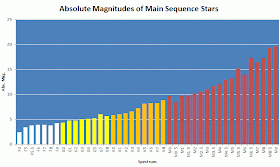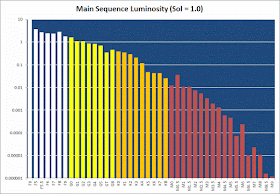One item I came across not long ago is a database of 997 of the nearest stars (998 if you include the Sun), all within about 45 light years (~14 parsecs). Of these, 688 Main Sequence stars have been classified and the totals for the five principal classes present are:
| A | 4 | 0.6% |
| F | 17 | 2.5% |
| G | 37 | 5.4% |
| K | 108 | 16 % |
| M | 522 | 76 % |
The Main Sequence is the stretched-S shaped curve that runs down and across a Hertzsprung-Russell diagram such as those shown in this article. It represents stars that are in the main hydrogen-burning phase of their existence. This "lifetime" ranges from about sixty million years for the hottest O type main sequence stars, through five to ten or more billion years for stars similar to the Sun in the middle of the sequence, to many billions and trillions of years for the smallest H-burning stars, the extreme red dwarfs. (Note: "dwarfs" is correct terminology for small stars. "Dwarves" is reserved for very short people.)
Of the main sequence stars that have been classified, I found 671 that were fully classified, that is, given an alphabetic class (A, F, G, K or M) and a subclass (a number from 0-9). The Sun is presently a G2 star. Leaving out the four A stars, I ran an analysis of each subclass, which can be charted thus:

(Click on this image and the one below for one about twice the size that is easier to read). First, what is Absolute Magnitude? It is the astronomer's measure of a star's brightness. Usually when someone says a star is of first or second magnitude, or whatever, they are speaking of apparent magnitude, the brightness as seen from the surface of the Earth. But if every star could be placed at the same distance, their intrinsic brightnesses could be readily seen. The standard distance for stellar astronomy is ten parsecs, or about 32.62 light years. At this distance, our Sun would be rather dim, at 4.83 magnitudes. On this chart, the bar for G2 is seen to be just under 5 magnitudes tall. The average of all five G2 stars (including Sol) within 45 light years is 4.77.
A parsec means "parallax arc-second". A star one parsec away (none are that close) will appear to move one arc second as compared to much further stars, as the earth moves through three months of the year. (Astronomers actually measure several times over a year, or several years, during which the Earth moves one AU in each of the four directions, giving a set of measurements for the star that can be adjusted for the motion of a single AU Earthside). A star at 10 pc moves 0.1 arc second during the same period.
When the subjective magnitude scale was regularized and made mathematical some 140 years ago, it was decided that five magnitudes would represent a factor of 100 in brightness. A quick glance at the axis of this chart shows that the magnitudes cover a range from about 2.5 to nearly 20, a range of ten million to one: An F0 star is ten million times as bright as an M9 star. Here we can draw a first conclusion about stellar duration. An F0 star weighs about 16 times as much as an M9 star, so divide 16 into 10,000,000, to find that the M9 star will burn hydrogen for 625,000 times as long. It is calculated that the F0 star can burn hydrogen for about 1.2 billion years, so the M9 will last 750 trillion years. This is why we don't know for sure whether M stars become red giants in a way at all similar to F, G, and K stars. None of them has been around long enough to make the transition! The Universe is "only" 13 billion years old.
Since this discussion is proceeding using brightness in terms of "x times" rather than magnitude differences, I offer this companion chart, in which the unit is the Sun's luminosity:

"Luminosity" is the formal term for brightness, including visible and invisible UV and IR light. Though the scale is logarithmic, its numerical labeling is easier to follow. Now we can see that the F stars range down from 10 to about 2 or a little less; the G stars are between 1.7 and just under half the Sun's luminosity; the K stars range from about 0.4 to 0.04, a 10:1 span; and the M stars range downward from there, to essentially zero for an M9.9 star, if any exist, that isn't fusing but a teacupful of hydrogen per year (OK, maybe a ton or two out of the 1025 tons available).
One reason for my interest is the search for planetary systems, particularly planets that might be in the habitable zone where liquid water can exist and persist for long times. The luminosity, color, and "lifetime" of a star are all relevant to the chances it will have a planet on which life can develop, assuming that our own existence means that life can easily develop given appropriate conditions.
Right away, one might say, "Let's look at the small M stars. They last trillions of years. Get life started on one of their planets, and it'll have a long, long time to evolve bug-eyed monsters (BEMs) we might be able to talk to."
M Stars?
Let's consider a star with 0.1 solar mass, probably about an M6. Luminosity is around 0.0002. Lifetime is 10 billion*0.1/0.0002 = 5 trillion years. One complication is that from the time the star begins fusing hydrogen until "turnoff" 5 trillion years later, its brightness increases by a factor of six. A planet that is in the habitable zone at year zero will eventually get cooked. Of course, the next planet out, if there are several, will probably enter the habitable zone about that time, and the changeover is likely to last long enough for some of the residents to relocate outward. They'll likely be able to stay there half a trillion or more years before the heating up jeopardizes their biosphere. But there are two big problems with mid-range and lighter M stars.
Firstly, most M stars are flare stars. The Sun produces an occasional flare that can disrupt our electrical gear and even cause blackouts. The energy hitting Earth increases by a few percent for a day or so, but brings with it a strong magnetic storm that causes havoc. A much smaller star can produce flares just as large, but the baseline—the star's brightness—is a thousand times smaller, meaning the planet has to be 30 times closer, and the flare hits a thousand times harder. Thus the flare can temporarily deposit ten times or more the energy intensity of what the star normally supplies. Lots of that will be UV and X-rays, so you'd need to live deep underground to survive the flare.
Secondly, it takes a planet at least Earth's mass to hold an atmosphere. If it is 30x closer to its star, it will soon become tidally locked, the way the Moon is tidally locked to Earth. Nobody knows what will happen then, but it is likely that all the water will migrate to the dark side and freeze, leaving the planet effectively barren. The way out of this is to have a super-Jupiter that has an Earth-size moon (this kind of system was posited for Pandora in the movie Avatar). The satellite would be tidally locked to its primary, but would rotate with respect to the star.
K Stars?
As it turns out, tidal locking and flaring are much less of a problem beginning near the M-K boundary. A K9 star (isn't it a pity neither of the "dog stars" has this designation!) has a luminosity near 0.05 and a mass near 0.7 of Sol. A mid-class K4 star is more like a dim Sun, with luminosity near 0.15 and mass near 0.9. K stars outnumber G stars three-to-one, being 16% of all main sequence stars. Along with most planetary astronomers, I think the best hunting ground for habitable planets is around K stars. They last 2-5 times as long as the Sun in the H-burning phase, and their brightness evolution is less extreme than an M star's, a range of about 2.5:1 over 20-50 billion years.
G Stars?
Of course, we know that at least one G2 star harbors a liveable planet. But there are a few drawbacks to living with a G star. Its brightness evolution is smaller than that of a K star, but is still significant, about 1.6:1 for the Sun, and 2:1 for a G8 star. And it happens quicker. Astrophysicists expect the Sun's increased brightness to boil off our oceans in another 500 million years. That's all the time we have left to develop interstellar travel, if it is possible at all.
The Earth needed a deep ocean in which life could develop in water deep enough that excess UV would not break apart fragile organic polymers such as proteins or RNA as quickly as they were formed. Life had to be protected from UV until it evolved photosynthesis and began to produce Oxygen, which automatically generated the protective ozone layer. This also reduced the carbon dioxide content of the atmosphere, just as the Sun was heating up (it is 40% hotter than it was four billion years ago).
In fact, the evolution of C4 photosynthesis about 100 million years ago gave us a further reprieve. C4 can drive CO2 levels to 50 ppm, but C3 can drive it only to 1000 ppm. The present level is 380 ppm, up from 280 ppm 150 years ago, but once we run out of oil and coal, it'll go back down. This whole "global warming" phase will end with an ice age long before the Sun gets hot enough to eliminate ice ages. So there are risks associated with G stars also.
Somewhere in this tremendous range of brightness, color, and so forth, there is sure to be a "sweet spot" for the development and nurturing of life. Maybe it really is the range that includes G2 stars, though it is more likely near the G-K boundary. And that is just the range in which we find the largest numbers of stable stars. The Kepler satellite is looking at stars of apparent magnitudes between 9 and 16, in a star cloud that is just distant enough that many of those are F, G, and K stars. The M stars, though they outnumber all the rest, are too faint for Kepler to get stable light curves. Give it time; I am sure a satellite with a more capable telescope will be sent up in another decade or so. Meanwhile, the more we learn, the more we find that there is to learn. We are not at the end of the development of astronomy. We are just getting going good!
Appreciate the recommendation. Will try it out.
ReplyDeleteAlso see my web site > ms exchange address book Recovery tool
Very nice post. I just stumbled upon your
ReplyDeleteweblog and wished to say that I've really enjoyed surfing around your blog posts. After all I will be subscribing to your feed and I hope you write again very soon!
My web page: best Access adp Repair software